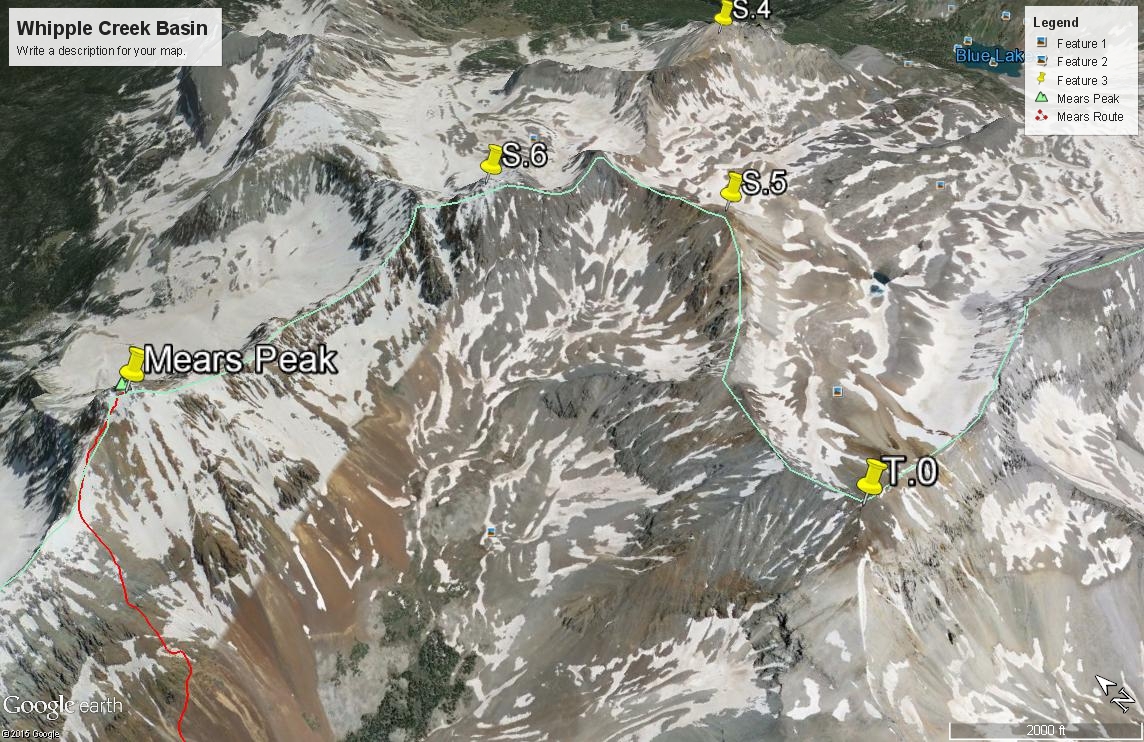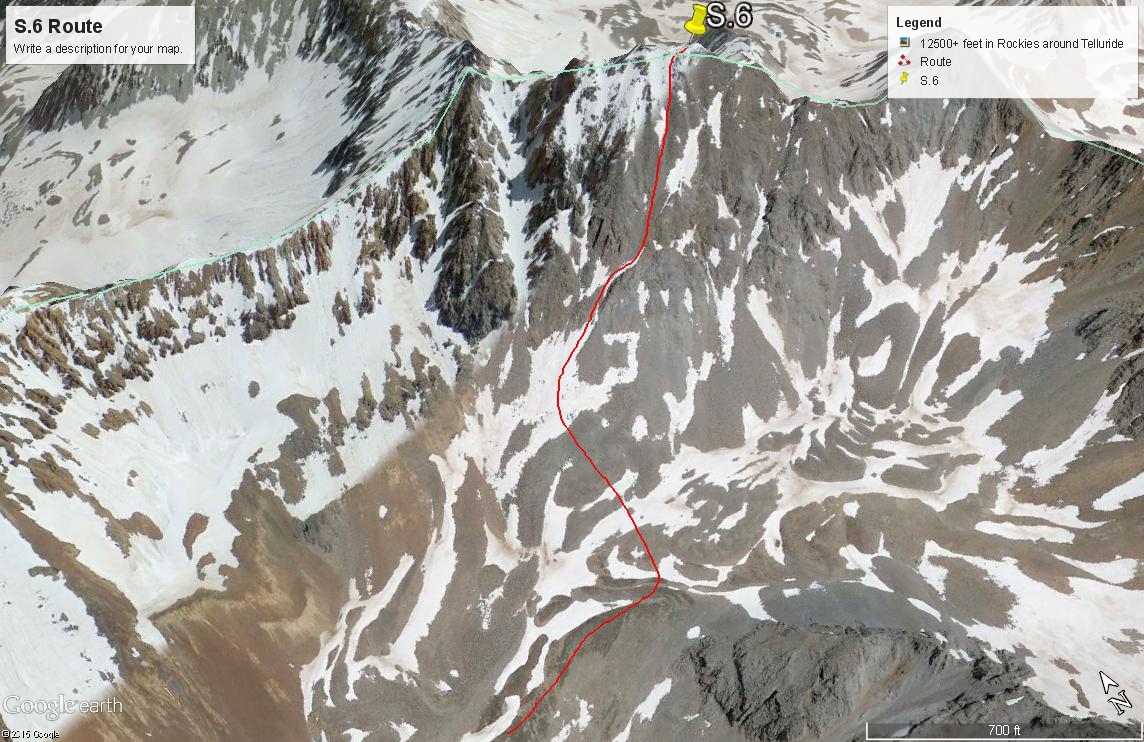LoJ: #289 (Pre-LiDAR #292) / 13,455' S 6
Peak Summary
A difficult Class 2+ ascent on boulder-rubble redeems itself by offering a hike into an isolated basin near Telluride populated with elk. Lidar measurements increased elevation by 14 feet.
S.6 South Face Access Route
-
Trailhead
Approach Map Photos
-
Sheep Ck-Deep Ck Trailhead
From SH145 at "Society Junction," 4 miles west of Telluride, drive on 145 just a little east past the junction and turn left (north) onto "Airport Road." On Trails Illustrated #141, this road is labeled the "Last Dollar Road," #638. The Uncompahgre NF map labels it similarly. Follow the road uphill and around a sharp turn at the head of a drainage. The road continues west past the Aldasoro Ranch entrance. Bear right when the Airport Road turns off for the Telluride airport. Continue NW and in under a mile, park at the coordinates provided on the right in a trailhead parking lot with a small corral. The Uncompahgre NF map indicates that this is the beginning for trail #418.1B. There is some private property across from the trailhead parking.
Camping
As with all peaks in the Telluride area, camp sites are at a premium. Because of the private property close by, trying to car camp at the trailhead is not advisable and not allowed anyhow. The closest designated campgrounds are the "Town Park" on the east end of Telluride and the "Sunshine" CG south of Society Junction on SH145. (Good luck trying to find an open site.) For anything else, your best bets will be back west on SH145 near the Silver Pick Road turnoff (CR60M); and south on CR63L/J several miles past Illium.
-
From Sheep Ck-Deep Ck TH via Iron Mtn Trail Base Camp
Because of the difficulty of the terrain and the fact that we wanted to climb 3 summits out of the basin south of Mears Peak, we made this trip into a backpack, hence an "approach" description for the backpacking segment.
From the trailhead, follow trail #418.1B northward for a short distance on an open slope. A sign at the TH calls this the Deep Creek and Whipple Trail access. It then switchbacks briefly to the south and then back north to eventually join an old roadbed beside a diversion ditch in an aspen forest. Follow this ditch for nearly a mile to where it crosses Sheep Creek. Past the creek, the trail turns west, still contouring, and then after about 200 yards, makes a sharp turn to the north. Continue along the ditch, ignoring a trail sign for a trail that heads down. After another half mile or so, the ditch intersects "Whipple Creek." That is the name for the creek that drains the basin on the south flank of Mears and S.7. This name does not show on most maps. On the USGS quad, the stream here has no name.
Cross over Whipple Creek on a bridge and pick up the trail on the other side. Hike for about 10 minutes as the trail follows the creek. The trail then makes a sudden turn to the left, goes up a little, then begins to head gently downhill, paralleling the creek. From that sharp left, hike about 10 minutes watching for an old grass-covered roadbed on the right that heads uphill. Follow it north. This becomes what the Uncompahgre NF maps labels as the "Iron Mountain trail, #418.1C. If our directions fail to get you there, this is the trail you want. The Trails Illustrated map shows this trail in brown, indicating it's a lesser trail that receives little if any maintenance. Hike on up this trail for nearly another 2 miles until it terminates at an old mine site at 10,862 ft. Below the mine tailings, contour on up the valley across rock and grass heading for the next group of trees at 10,800 to 10,900 ft. and a nice grassy area on the south side of the creek. Hike a short distance up a small ridge and you should be able to locate a good campsite in the lush grass.
Camping
The best camping will be as described above, at an elevation of 10,800 to 10,900 ft. approximately, in grassy, open areas amid the sparse trees.
Open This Approach in a New Window
Route Map Photos
Route Info S.6 South Face Access
Route Description
Year Climbed: 2002The Guide To the Colorado Mountains 9th Edition offers a possible route by hiking to the saddle between UN13,410 (S.5) and S.6, then following up the south and east ridge of S.6 to reach the summit. Our more direct route takes you up the south facing gullies of S.6. The route description assumes a backpack into the basin south of Mears and S.6 on the Iron Mountain Trail and a campsite location at about 10,900 ft. Mileage and elevation gain for S.6 are measured from that possible campsite.
From the trees and grassy areas at 10,800 - 10,900 ft., hike up valley on the south side of the stream through trees utilizing sporadic game trails. You have an excellent choice of spotting some elk through here. the trees will end at about 11,700 ft. Keep following the tundra on the side of the stream course and walk up to a tundra bench level just below 12,000 ft. Stroll on up this bench and then ascend another pitch on mostly tundra to a higher basin at 12,300 ft. This will be your last tundra. Everything above here is mostly lichen-encrusted rock. The summit of S.6 can be seen from here as the highest point you can see on the summit block, NNE from where you stand.
Dropping from the summit, there are two, shallow, parallel couloirs. The one on the right is what you can aim for. Both of the couloirs empty into another that slashes diagonally across the south face of the peak, and from your present vantage point, cannot really be seen. It is hidden by a protruding rock rib in the center of the south face, that follows a similar diagonal line, ascending from the left to the right. Head for the left end of this rock rib, walking gingerly over 200 - 300 feet of boulder rubble. (In earlier season, there may be snow in areas, especially behind this rib.) Behind the rock rib, you'll see the gully that follows alongside the rib. Head up the gully and use the walls of the rock rib for a handrail as you try to amble up more precariously perched rubble.
As the gully begins to play out, take the second (higher) of two couloirs that drop into the present gully from your left. You'll be hiking on more of the same rubble, and the going is steep and slow, but perhaps a little more stable than earlier. Once you reach the head of this couloir, turn right for the true summit.
For descent, we recommend returning as you came. We investigated the west ridge that leads over to Mears and found a substantial, near vertical drop that appeared technical to us, however, a register on Mears indicated one person claiming to have negotiated the S.6 - Mears traverse.
-

